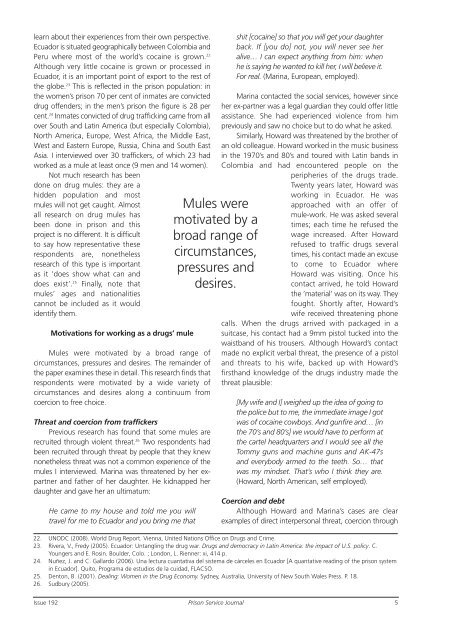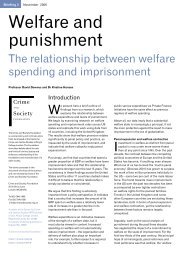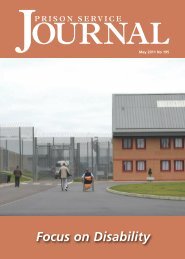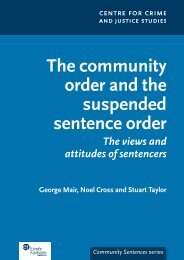and Nigeria. 8 This varies according to national context:for example a large portion of drug mules in Australiaare from Thailand and Vietnam. 9 Research in the USAfinds a high portion of women mules are from Jamaicaand South America. 10 A significant portion of womenmules are single parents. Research on Colombianwomen mules in prison in Europe found that 85 per centwere single parents. 11 This is also true of women mulesfrom Jamaica imprisoned in the UK and the USA. 12To an extent, these demographics can be interpretedto explain the phenomenon of drug mules. The firstresearch on the subject, conducted by Rosa del Olmo inVenezuela, concluded that economic crisisdisproportionately affected women and contributed totheir entry into the international cocaine trade as mules. 13This hypothesis has been largely borne out in researchwhich asks mules about their motivations. Research withfemale Colombian mules found that many weremotivated by financial concerns connected to women’srole as the head of the household. 14 Likewise, researchwith Jamaican mules found that most women weremotivated by economic need. 15 Writing twenty years afterRosa del Olmo, Julia Sudbury similarly concludes that neoliberaleconomic globalisation has exacerbated developingworld poverty and women continue to bedisproportionately affected as the financial heads of thehouseholds. 16Penny Green conducted research with Nigerian menand women imprisoned in the UK. She concludes that forboth: ‘relative poverty, a sense of desperation andopportunity to rise above the grinding misery of economichardship in the developing world all contribute to arational explanation of the phenomenon’. 17 Her researchwith British mules found that they were motivated bysimilar concerns as those mules from the developingworld: debt, economic distress and (in the 6 cases of 130female couriers which she presents) ‘external pressure’from older, more powerful men. 18 In addition she foundthat six (of the 18 couriers she interviewed) were ‘the veryyoung who see it as part of an exciting lifestyle and/or ameans to another better way of life’. 19Lastly, some research has highlighted the role ofcoercion and threat in motivating drug mules. 20 This claimremains contentious as it is extremely difficult for mules toprove that they were coerced. On the other hand, there isa widespread belief that mules may ‘cry wolf’ in the hopeof a more lenient sentence but on the other hand mulesmay not speak to the authorities for fear of retribution.In sum, existing research shows that deprivation isundoubtedly an important context in mules’ motivations.However, since research has tended to focus only mulesfrom the developing world, it is hardly surprising that theyshould cite poverty as a motive when they find themselvesimprisoned in the developed world. Furthermore, to saythat people commit crime because of poverty issomewhat simplistic: it does not explain why peopleoffend at a particular time, why one type of crime iscommitted over another, or why more men than womenare mules, if women are disproportionately affected byeconomic crisis. Lastly, existing research has mostlysidelined the possibility alternative or simultaneousmotives for offending. Research on women drug dealersuncovered a much wider variety of motivations thanresisting poverty such as autonomy, respect, gaining asense of control over their lives, achieving respectability aswell as enjoyment. 21 Thus the purpose of this research wasto re-examine the motives of a diverse group of mulesand in particular to consider what the role of povertymight be.Methodology and participantsData for this research was collected through 15months of ethnographic research in women’s and men’sprisons in Quito, Ecuador. The researcher spent 4-5 days aweek in prison with convicted drug traffickers in order to8. Sudbury, J. (2005). ‘Mules,’ ‘Yardies’ and other folk devils: Mapping cross border imprisonment in Britain. Global lockdown: race,gender, and the prison-industrial complex. J. Sudbury. New York, N.Y. ; London, Routledge: xxviii, 323 p.Green (1994).9. Australian Bureau of Statistics (2010), Prisoner Characteristics: Australia, available online:http://www.abs.gov.au/ausstats/abs@.nsf/Products/4517.0~2009~Chapter~Prisoner+characteristics,+Australia?OpenDocument#21302313271899535399213023132718995010. Huling, T. (1995). “Women drug couriers: Sentencing reform needed for prisoners of war.” Criminal Justice 9(15).11. Dorado, M.-C. (2005). Desventajas del castigo penal ‘exclusivo’ a las colombianas, mensajeras de drogas en Europa [Disadvantages ofthe ‘exclusive’ penal punishment of columbian drug messengers in Europe]. Delitos y Fronteras:Mujeres extranjeras en prisión [Crimesand Borders: Foreign women in prison]. M. T. Martín Palomo, M. J. Miranda López and C. Vega Solís. Madrid, Editorial Complutense.12. Sudbury (2005, see also Huling, T. (1995). “Women drug couriers: Sentencing reform needed for prisoners of war.” Criminal Justice9(15).13. Olmo, R. D. (1990). “The Economic-Crisis and the Criminalization of Latin-American Women.” Social Justice-a Journal of CrimeConflict and World Order 17(2): 40-53.14. Dorado, ibid.15. Sudbury (2005).16. Ibid.17. Green, P. (1998). Drugs, trafficking and criminal policy: the scapegoat strategy. Winchester, Waterside Press.. p. 18.18. Ibid.19. Ibid, p.93.20. Sudbury (2005).21. Denton, B. (2001). Dealing: Women in the Drug Economy. Sydney, Australia, University of New South Wales Press.4 Prison Service JournalIssue 192
learn about their experiences from their own perspective.Ecuador is situated geographically between Colombia andPeru where most of the world’s cocaine is grown. 22Although very little cocaine is grown or processed inEcuador, it is an important point of export to the rest ofthe globe. 23 This is reflected in the prison population: inthe women’s prison 70 per cent of inmates are convicteddrug offenders; in the men’s prison the figure is 28 percent. 24 Inmates convicted of drug trafficking came from allover South and Latin America (but especially Colombia),North America, Europe, West Africa, the Middle East,West and Eastern Europe, Russia, China and South EastAsia. I interviewed over 30 traffickers, of which 23 hadworked as a mule at least once (9 men and 14 women).Not much research has beendone on drug mules: they are ahidden population and mostmules will not get caught. Almostall research on drug mules hasbeen done in prison and thisproject is no different. It is difficultto say how representative theserespondents are, nonethelessresearch of this type is importantas it ‘does show what can anddoes exist’. 25 Finally, note thatmules’ ages and nationalitiescannot be included as it wouldidentify them.Motivations for working as a drugs’ muleMules were motivated by a broad range ofcircumstances, pressures and desires. The remainder ofthe paper examines these in detail. This research finds thatrespondents were motivated by a wide variety ofcircumstances and desires along a continuum fromcoercion to free choice.Threat and coercion from traffickersPrevious research has found that some mules arerecruited through violent threat. 26 Two respondents hadbeen recruited through threat by people that they knewnonetheless threat was not a common experience of themules I interviewed. Marina was threatened by her expartnerand father of her daughter. He kidnapped herdaughter and gave her an ultimatum:He came to my house and told me you willtravel for me to Ecuador and you bring me thatMules weremotivated by abroad range ofcircumstances,pressures anddesires.shit [cocaine] so that you will get your daughterback. If [you do] not, you will never see heralive… I can expect anything from him: whenhe is saying he wanted to kill her, I will believe it.For real. (Marina, European, employed).Marina contacted the social services, however sinceher ex-partner was a legal guardian they could offer littleassistance. She had experienced violence from himpreviously and saw no choice but to do what he asked.Similarly, Howard was threatened by the brother ofan old colleague. Howard worked in the music businessin the 1970’s and 80’s and toured with Latin bands inColombia and had encountered people on theperipheries of the drugs trade.Twenty years later, Howard wasworking in Ecuador. He wasapproached with an offer ofmule-work. He was asked severaltimes; each time he refused thewage increased. After Howardrefused to traffic drugs severaltimes, his contact made an excuseto come to Ecuador whereHoward was visiting. Once hiscontact arrived, he told Howardthe ‘material’ was on its way. Theyfought. Shortly after, Howard’swife received threatening phonecalls. When the drugs arrived with packaged in asuitcase, his contact had a 9mm pistol tucked into thewaistband of his trousers. Although Howard’s contactmade no explicit verbal threat, the presence of a pistoland threats to his wife, backed up with Howard’sfirsthand knowledge of the drugs industry made thethreat plausible:[My wife and I] weighed up the idea of going tothe police but to me, the immediate image I gotwas of cocaine cowboys. And gunfire and… [inthe 70’s and 80’s] we would have to perform atthe cartel headquarters and I would see all theTommy guns and machine guns and AK-47sand everybody armed to the teeth. So… thatwas my mindset. That’s who I think they are.(Howard, North American, self employed).Coercion and debtAlthough Howard and Marina’s cases are clearexamples of direct interpersonal threat, coercion through22. UNODC (2008). World Drug Report. Vienna, United Nations Office on Drugs and Crime.23. Rivera, V., Fredy (2005). Ecuador: Untangling the drug war. Drugs and democracy in Latin America: the impact of U.S. policy. C.Youngers and E. Rosin. Boulder, Colo. ; London, L. Rienner: xi, 414 p.24. Nuñez, J. and C. Gallardo (2006). Una lectura cuantativa del sistema de cárceles en Ecuador [A quantative reading of the prison systemin Ecuador]. Quito, Programa de estudios de la cuidad, FLACSO.25. Denton, B. (2001). Dealing: Women in the Drug Economy. Sydney, Australia, University of New South Wales Press. P. 18.26. Sudbury (2005).Issue 192 Prison Service Journal5











